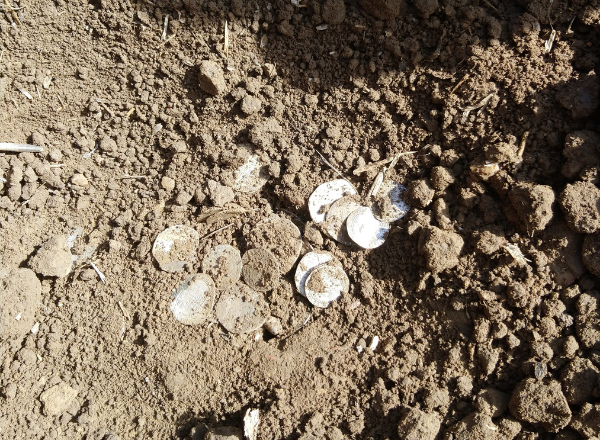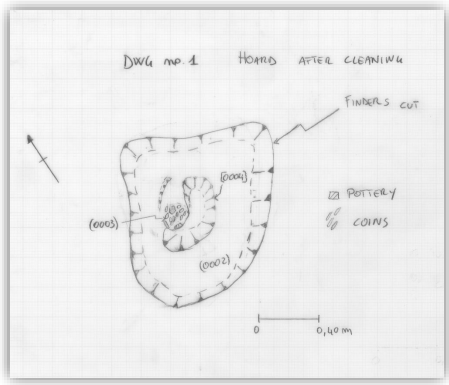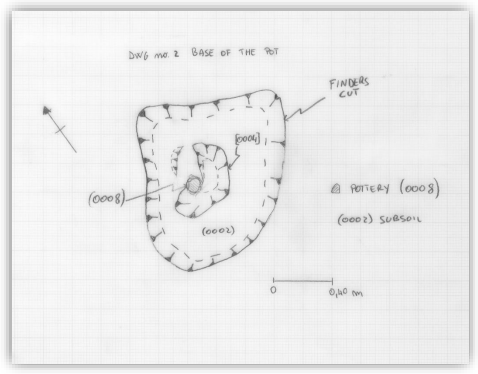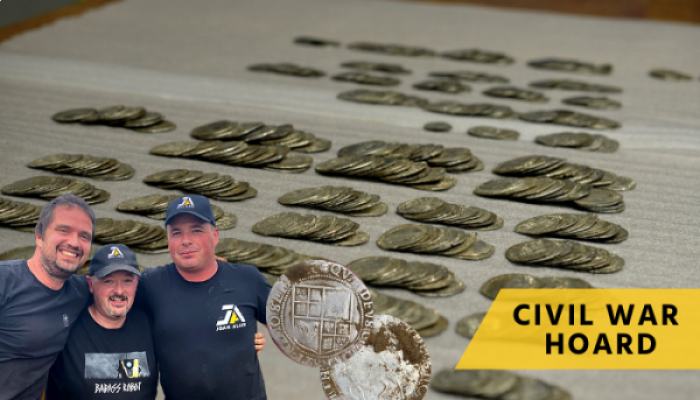Hello dear readers,
It’s been a while since I updated you on the progress of the hoard and have yet to finish the tale of its finding and recovery.
As we near the end of yet another lock down due to the dreaded virus, it seems that 2020 was a very long year and in 2021 it’s still not over!
For me it has affected every aspect of my life, I have however worked all the way through due to my job and have even managed to come out kind of on top?
This is due to my company splitting my group into two and doing shifts (with a nice allowance), so if one shift goes down with Covid, we can continue to produce first to patient clinical trial medications. These have of course most recently been COVID-19 related; but also, many other horrible ailments the worst of which is one I really hate, cancer in all of its many forms.
Throughout the whole sad affair lock down guidance on detecting has had me flummoxed with contradictions and strange decisions being made, our beloved hobby has been for those of us that do not have our own permissions to detect or live more than five miles (by bicycle or on foot) from our permissions and do not live near the coast; made near impossible. I still have no permission that is available within these limitations unfortunately.
I have also noted that things have been moving behind the scenes on legislation regarding our hobby, specifically with the 1996 treasure act that I encourage you to read up on and follow:
UK to Change Treasure Act – New Restrictions Proposed (culturalpropertynews.org)
I do hope this is not a sign of things to come for the future of detecting here in England. However, being unable to get out in the fields has meant that I have time to build up brownie points with my better half and get those jobs done around the homestead.
More to the point it has given me time to reflect, read, research and come up with suppositions as to the hoard. I left off last time on the evening of the fateful Sunday that we found the hoard:

We had just made the decision that we should stop our digging of what we more or less knew was the hoard pot itself and had received a call from the Suffolk Finds liaison officer (FLO), who arranged that he would meet us at the local pub the Lindsay Rose at 09:00 the following day.
From that moment we were still in shock but decided it was now clearly party time, unfortunately being a Sunday evening, the pub was closed so Luke’s lovely wife Syrie again sprang into action and magically produced (I think even the neighbours chipped in a couple of bottles?) enough loony juice for us all to have a very merry time. The night was interspersed by sporadic “dancing” to old school tunes and pitch black slightly wobbly detecting with the aid of the very handy back lit display and underside torch of the Quest X10 (such a well thought out machine for an entry level unit).
I believe during the night we actually managed to recover a further 32 coins!
The next morning, we all dragged ourselves from our cars and reversed Luke’s pick up from over the hoard hole. Syrie supplied bacon rolls and strong coffee with lashings of paracetamol to aid our recovery from the night’s festivities.
It was already warming up and the field had a slight mist rolling away and slowly being burnt off by the rising sun, from across the field we could see a horse appearing through the mist heading straight for us. It was honestly like the original owner of the hoard was returning after all these years to reclaim his prize.
I joked that it was a mounted nighthawk, but as the rider drew nearer, we discovered it was the landowner.
He was very interested in what we had found and we gave a brief rundown of what had happened and what we believe we had found and with that he was gone into the misty morning again.
A few minutes later we received a call from the FLO Riccardo to inform us that he was on his way and within the hour he had pulled up alongside our little encampment and was hurriedly pulling all manner of digging equipment and archaeological paraphernalia from his car. At this point the Live stream went on and our once in a lifetime experience were shared far and wide within the detecting community.
To see it all again or if you didn’t tune in on the day please CLICK HERE
The FLO worked extremely hard to recover the hoard, when we thought he was finished our pin pointers and detectors just kept finding more. The mist of the morning had by this time turned into drizzle, however it didn’t dampen our spirits and if anything spurred the FLO on to recover the hoard and record its context in detail.
Please see below some of the details:


After the main pot was removed and taken away to be cleaned and catalogued at the British Museum, we continued our search the area of the scatter both up and down from the main hoard as the plough had dragged the coins some 30 or more meters in some cases. The lads were using the Equinox 800’s and I was still using the Quest Q30+ and I have to say I was finding just as many coins as they were. I found it to be an invaluable learning experience for the machine that I had been using since only the day before and found coins of differing denominations/ monarchs and sizes at all sorts of depths and angles (I recall a fair few were on edge and as we all know these signals can be tricky) the plough had definitely done its job.
As the evening drew in, we all decided due to restrictions and bubbling, that we should make our way home for a good night’s sleep and return the following day rather than try and find a local B&B that was still taking people in. I have to say I was out like a light as soon as my head hit the pillow that night.
Back in the field the next day we were joined by Gordon Heritage and his wonderful collection of metal detecting awesomeness. It really was a sight to behold; however, I cannot go into too much detail as to what equipment we were using.
We shot a few more videos of Gordon cherry picking targets with a Minelab GPX (not sure what coin?), while Dan and I did the digging.
I was also amused at some of the feedback from the live feed about me using a shorty shovel or a “Back breaker” as some call them. I am short, there’s no escaping it; however even the lads had to agree that it was invaluable during the hoard hole digging and was much easier to use in a confined space than a conventional spade.
Needless to say, I never suffered with a bad back from using one even over those few days of constant digging.
After we had thoroughly searched the site again, we had found a further 35 coins, enough to bring our total for the hoard to 1080 and at that point we agreed that anything else would be beyond the reach of a conventional detector and conventional methods of detecting. The coins found after the hoard recovery by the FLO, were later delivered to them by Luke.
We later found from the initial report the full break down of the coins that a total of 458 coins were found in the top soil and spread from the plough, and 622 had remained in the main hoard pot.
Towards the end of the year, we received the report of the catalogued coins, this was to say the least a massive spreadsheet and was at first staggering to just scroll through, with each line item, not being just one coin but multiple.
The hoard contains coins from Edward VI (1537) to Charles I (1625 until he got the chop) and all rulers in between.
I was also informed that the Lindsay hoard is the second largest Civil war hoard of its kind to be discovered.
Now to some supposition, why and who and how.
As said in the curators report I received:
“The hoard was deposited in the reign of Charles I during the first English Civil war at a time when there appears to be an increase in hoarding activity linked directly to contemporary events. (Besly 2015)”
All well and good but a bit clinical and lacking in interesting questions and answers. So really it just answers the why or does it?
Well not really.
There was a war, people were scared and there was massive civil unrest and a LOT of deaths, not just on the Roundhead and Cavaliers ranks but also civilians.
Some facts and figures to put things in perspective.
On the side of Charles I 50,700 dead 83,467 captured.
On the side of Oliver Cromwell 34,130 dead 32,823 captured.
The average man in the street minding his own business, non-combatants reached a staggering 127,000 deaths. Events such as the storming of Bolton often referred to as the “Bolton massacre”, where it is alleged that 1600 of Bolton’s defenders and inhabitants were butchered by Royalist forces led by Prince Rupert both during and after the fighting certainly added to this number. But the unseen killer of war related diseases such as typhoid, dysentery, cholera, scarlet fever and plague ravaged the country also decimating civilian populations.
Considering Suffolk’s close links with the Eastern Association (comprising of Parliamentarian militias of Essex, Hertfordshire, Norfolk, Cambridgeshire and Suffolk), which became the mainstay of the Parliamentarian military force towards the end of 1644 (the latest coins in the hoard were mint marked with R indicating they were issued during the period of 1644-1645).
I would have to surmise that anyone of any import in the area, with significant assets would very much like to liquidate those assets be they for or against whatever faction.
Maybe a forward-thinking member of the clergy that would have been well aware of the way the wind was changing and that the many of the amazing wool churches of Suffolk were taking a beating at the puritanical hands of Cromwell and his protestant reformers such as William “Basher” Dowsing who was appointed to inspect some 150 churches in Suffolk between 1643-44, who would see their finery and beautiful alters, murals, fonts and even their stained glass as Papist idolatry.
Some people have suggested and it had crossed my mind that what we had found could be a local military payroll, I have ruled this out after some reading…I have been doing a lot of reading. Purely because there isn’t enough of it. Yes, there could have been an encampment nearby at say Lindsay castle which would have been an ideal and strategic place to have a marching camp in the area, however Suffolk was a Parliamentarian stronghold so why bother?
Let’s just suppose the local Lord of the Manor was a Royalist sympathiser or even a Catholic…he would be wanting to get the hell out of dodge!
So, he liquidated his assets, sold off his prized possessions and converted it all to silver coinage the highest value denomination being half-crown’s.
Why did he change it to silver and why not gold? The answer is simply that it is easier to pass off small denomination currency, even in large amounts. Imagine walking into a shop today with a stack of fifty-pound notes, attention would be paid; whereas no one would bat an eyelid to fives, tens and twenties.
Now let’s think about the Pot the hoard was in, why use a pot? Well, it’s something that would have been easily at hand, but also why not us a burlap sack or a saddle bag. That amount of silver disks would have been unwieldy in a sack or a saddle bag and also as you went on your merry way with them, they would move about and make that lovely ‘chink-chink’ noise of multiple coins bouncing about. Also, what if you bumped into someone “Hello, hello, hello, what’s in the sack?” or a saddle bag “going somewhere?”
No, a nice pot could hold a serious amount of coinage, was readily available and if stacked in tightly would make no tell-tale noise in transit. You could even cover the top in whatever you wanted, say flour to muffle any noise as well as have a reasonable excuse to be carrying it. Also, a nice solid pot could be easily stowed away in the crook of your arm under a cloak, a saddle bag or sack would be a real pain in the neck to hide.
This brings us to the when, what time of day would be best and provide a reasonable excuse.
I would think most likely early evening at dusk. Farm labourers would have returned home around this time and were doing what would have been required at home before popping to the pub in the evening. So, the reasonable excuse would have been to go to the pub and bury the hoard on the way. That way you could say you were on the way to the pub and also doing it on the way there the local focal point would have been the pub so you would know if you had been spotted “what were you doing in that there field?” and if you had been spotted you could retrieve the stash on your way home if you weren’t too sozzled, and that’s another good point you wouldn’t want to be burying a hoard on your way back from the pub in the dark, you may never find it again!
Now the where, looking at the crop marks of the area and then referencing old maps I can see that the hoard was located at a dog leg in the road and within a few feet of a now non-existent field boundary, with the pub included as a reference point one could easily within a few paces triangulate where the hoard was located upon returning. Unlucky for the person who deposited it there they don’t seem to have returned, I guess we will never know their fate; but I would think it was not a nice one to not have returned to locate their fortune (luckily for me and my friends).
So where are we in the process now and what has happened since?
The Lindsay hoard as it is now known currently resides at the British Museum slowly working its way up the Curators list to approve its final report and move on in its next step to be declared as treasure. I have to say that at the time Luke would have liked to call it the Syrie Hoard after his better half, however there are naming conventions that need to be adhered to apparently (news to us), it would have been a nice thing to have done, but I guess rules is rules eh?
To get this far we have had the original FLO report, it then went on to be catalogued on a spreadsheet of awesome detailing denomination and sovereign and number of each. At this point we have been told that there were a few coins, one in particular that was proving troublesome to identify (the suspense is palpable).
Here’s a few pictures care of the Suffolk FLO team to wet the appetite before I sign off until next time:
-

©Suffolk County Council -

©Suffolk County Council -

©Suffolk County Council -

©Suffolk County Council
I have to say it seems like a dream now, a distant foggy but amazing dream.
The staff of the FLO team at Suffolk county council have been very helpful and responsive throughout the process so far and we look forward to be able to put names to faces eventually however due to the pandemic, we have not been able to see the hoard although we all long for that day and it will make an amazing day trip for Luke, Dan and myself once all this is over.
I will continue to keep you updated as and when I know more.
Happy Hunting!
Blog by Matt Brown

